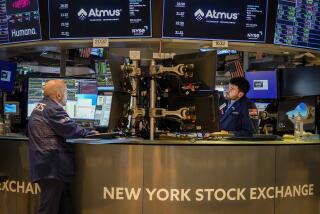O Yield of Little Faith : When It Comes to Bonds or Bond Funds, Too Much Emphasis on These Figures Can Lead You Astray
- Share via
It’s true that looks can be deceiving. And in the world of bonds, there is probably nothing more deceiving for unsophisticated investors than yield figures.
In comparison-shopping among individual bonds and bond mutual funds, investors will come across terms such as “current yield” and “30-day net annualized SEC yield” and “distribution yield.” Each figure represents a different calculation of performance, and investors should understand the nuances to make informed choices.
“There are all types of yields out there, and investors must be careful to know the difference,” said Mark Wright, a fixed-income analyst with Morningstar Inc., the mutual fund tracker in Chicago.
Consider the Alliance Corporate Bond Fund A, an $860-million fund. What does it yield to investors? That depends. It has an SEC yield of 7.12%, but an 8.07% current yield and an 8.56% distribution yield.
The SEC yield is the standardized measure created by the Securities and Exchange Commission in 1988 to enable investors to better compare mutual funds.
This yield is an annualized representation of the yield investors received over the last 30 days. But the figure is more complicated in calculation than other yields because it excludes certain things and requires other types of adjustments, to put investments on a more level playing field.
“The SEC yield is as close as we can get” to making a good comparison among funds and individual bonds, said Larry Friend, a chief accountant for the SEC.
The current yield, meanwhile, is the annual “coupon” level of interest paid on an individual bond divided by the bond’s latest price. Or, in the case of a bond mutual fund, it would be the current level of dividends paid, annualized, then divided by the fund’s latest net asset value per share.
For example, an individual bond selling for $1,000 with a $100 annual coupon offers a 10% current yield. If that same bond were selling for $500 it would offer a 20% yield to an investor buying it at that price.
In addition, Morningstar provides fund investors with what it calls a distribution yield. This figure is calculated by taking the actual income (dividend) distributions over the last year--which may have been higher or lower than the current level of income being paid--and dividing that figure by the latest net asset value of a fund.
Sound confusing? There’s more.
In the view of Morningstar’s Wright, the best measure of an individual bond’s return is “yield-to-maturity,” which factors in not only current yield but also future interest and any principal gain or loss on the bond if held to redemption.
“This figure measures the total return an investor’s portfolio will have if they hold onto the bonds until they mature,” Wright said. “It’s the best way to know what you’re going to get.”
Yield-to-maturity isn’t relevant for bond mutual funds, however. From an investor’s point of view, bond funds never “mature,” because new bonds are continually replacing maturing ones in the portfolio. Managers of a bond fund might calculate yield-to-maturity for a portfolio at a certain moment in time, by breaking down the yield-to-maturity for individual bonds and then weighting each in the overall portfolio, but the figure would be constantly changing.
For bond funds, the relevant long-term measure of performance is “total return.” That is the measure of return that counts both the yield paid in a given period, and the appreciation or depreciation of the fund’s share value, which fluctuates with changes in market interest rates. (Bonds, and bond funds, fall in value if market interest rates rise, and vice versa.)
The most important thing for bond investors to remember: Be careful not to pay too much attention to yield.
“You might be making some big mistakes if you invest solely on the basis of yield,” Wright warned.
Although investors have access to much better information now, he said, they can still be deceived.
If you’re attracted by a high yields, here are two things to keep in mind:
* A fund may be “over-distributing” yield. Because mutual fund firms know that bond investors have an inclination to be biased on the basis of yield, some funds boost their current yields at the expense of share value in order to attract new investors, Wright said. That “extra yield,” or over-distribution, comes directly out of an investor’s principal investment in a fund and will be reflected in a declining net asset value over time, he said.
The SEC yield figure was designed specifically to be a check on this practice.
One former offender, said Wright, is the John Hancock Sovereign U.S. Government Fund Class B.
Two years ago, Morningstar analyst Andrew Lohmeir found the fund manager was starting down “a strange course by pouring assets into higher-coupon CMOs [collateralized mortgage obligations] to boost the fund’s yield. . . . Such ‘premium’ coupons might help mask expenses by juicing yield, but they ultimately erode net asset value” because the bonds mature for much less than the fund paid for them.
The fund says it has stopped the practice, Wright said.
* Higher yield means higher risk. Investors shopping only on the basis of yield might take on more risk to their principal than they had ever expected or wanted.
The bottom line: Think about total return and how much you can stand to lose in principal value if market interest rates fluctuate dramatically.
“People have a strong inclination to look at yield,” Wright said, “but after calculating for all the other factors, it is just better to look at total return.”
Times staff writer Debora Vrana can be reached at debora.vrana@latimes.com
More to Read
Inside the business of entertainment
The Wide Shot brings you news, analysis and insights on everything from streaming wars to production — and what it all means for the future.
You may occasionally receive promotional content from the Los Angeles Times.










